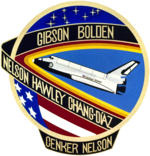STS-61-C
| Mission emblem | |||
|---|---|---|---|

|
|||
| Mission dates | |||
| Mission: | STS-61-C | ||
| COSPAR-ID : | 1986-003A | ||
| Crew: | 7th | ||
| Begin: | January 12, 1986, 11:55:00 UTC | ||
| Starting place: | Kennedy Space Center , LC-39A | ||
| Landing: | January 18, 1986, 13:58:51 UTC | ||
| Landing place: | Edwards Air Force Base , Runway 22 | ||
| Flight duration: | 6d 2h 3m 51s | ||
| Earth orbits: | 98 | ||
| Track height: | 393 km | ||
| Orbit inclination : | 28.5 ° | ||
| Covered track: | 4.0 million km | ||
| Payload: | SATCOM KU-1 | ||
| Team photo | |||
 v. l. No. Robert Cenker, Charles Bolden, Bill Nelson, Steven Hawley, George Nelson, Robert Gibson, Franklin Chang-Diaz |
|||
| ◄ Before / After ► | |||
|
|||
STS-61-C ( english S pace T ransportation S ystem ) is a mission designation for the US Space Shuttle Columbia ( OV -102) of NASA . The launch took place on January 12, 1986. It was the 24th space shuttle mission and the seventh flight of the Columbia space shuttle.
team
Main team
- Robert Gibson (2nd space flight), commander
- Charles Bolden (1st spaceflight), pilot
- Franklin Chang-Diaz (1st spaceflight), mission specialist
- Steven Hawley (2nd spaceflight), mission specialist
- George Nelson (2nd spaceflight), mission specialist
- Robert Cenker (1st Spaceflight), Payload Specialist, RCA Electronics
- William "Bill" Nelson (1st space flight), payload specialist, politician
replacement
- Gerard Magilton for Cenker
Start preparations
The original launch date of December 18, 1985 was postponed several times, first by one day, because the Columbia's cargo bay could not be closed. During the take-off attempt on December 19, an incorrect display of a sensor on the launch ramp forced the launch to be aborted at T-14 seconds. A next attempt on January 6th was aborted at T-31 seconds because 1,800 kg of liquid oxygen had been pumped out of the external tank by mistake. On January 7, two emergency landing sites in Spain and Senegal reported poor weather conditions, so the countdown had to be stopped at T-9 minutes. A broken liquid oxygen sensor on the launch pad was responsible for the aborted take-off on January 9, which threatened to block a valve in the shuttle's main engine. Finally, the start date set for January 10 had to be postponed by another two days due to heavy rain in Cape Canaveral .
Mission overview
The mission of the STS-61-C was to put the communications satellite SATCOM KU-1 into orbit. A program for observing Comet Halley could not be carried out as planned due to battery problems in the camera. There were also other experiments on board the shuttle, three of which were part of NASA's SSIP student program.
The landing was originally scheduled for January 17th at the Kennedy Space Center in Florida . In view of the delays at the start, the mission management decided to shorten the mission by one day in order to save time for maintenance work between flights. However, the weather in Florida did not allow a landing on January 16 or on the two following days. Finally, after an additional orbit around the world, the space shuttle landed at Edwards Air Force Base in California .
The Columbia was transported back to the Kennedy Space Center for refueling on January 22nd and 23rd by means of one of the two shuttle carrier aircraft with several stopovers.
See also
Web links
- NASA Mission overview (English)
- Video summary with comments of the crew (English)
- STS-61-C in the Encyclopedia Astronautica (English)
Individual evidence
- ^ Space Shuttle Chronology. NASA, accessed January 30, 2018 .
- ^ Shuttle Columbia STS-61-C (24). In: Vectors. Greg Goebel, January 1, 2017, accessed January 30, 2018 .
